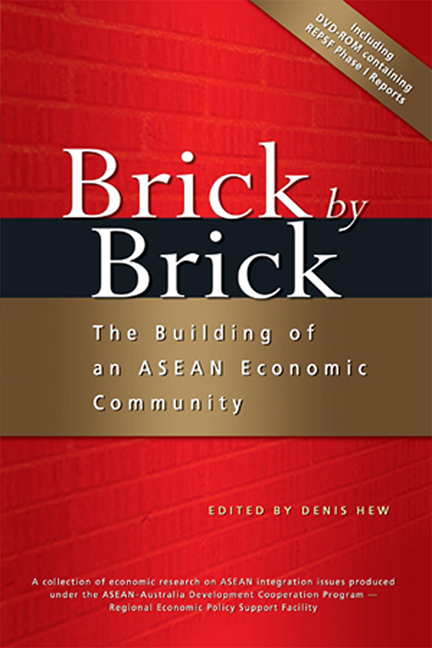Book contents
- Frontmatter
- Contents
- Foreword by Ong Keng Yong
- Foreword by Bruce Davis
- Acknowledgements by Academic Editor
- Acknowledgements by Technical Director REPSF
- The Contributors
- The Regional Economic Policy Support Facility
- 1 Introduction: Brick by Brick — The Building of an ASEAN Economic Community
- 2 What is a Single Market? An Application to the Case of ASEAN
- 3 The Challenge of Economic Integration for Transitional Economies of Southeast Asia
- 4 A Review of Regional Tariffs and Trade in the ASEAN Priority Goods Sectors
- 5 Non-tariff Barriers to Trade in the ASEAN Priority Goods Sectors
- 6 An Assessment of ASEAN's Priority Sectors for Fast-track Integration
- 7 ASEAN Tax Regimes: Impediment or Pathway to Greater Integration
- 8 An Overview of the Foreign Direct Investment Jurisprudence
- 9 ASEAN's FTA Negotiations with Dialogue Partners:Identifying Strengths and Weaknesses in Business Opportunities
- 10 Conclusion: Towards an ASEAN Economic Community by 2015
- Index
- Contents of Accompanying CD-ROM: AADCP-REPSF Phase I Research Program
2 - What is a Single Market? An Application to the Case of ASEAN
Published online by Cambridge University Press: 21 October 2015
- Frontmatter
- Contents
- Foreword by Ong Keng Yong
- Foreword by Bruce Davis
- Acknowledgements by Academic Editor
- Acknowledgements by Technical Director REPSF
- The Contributors
- The Regional Economic Policy Support Facility
- 1 Introduction: Brick by Brick — The Building of an ASEAN Economic Community
- 2 What is a Single Market? An Application to the Case of ASEAN
- 3 The Challenge of Economic Integration for Transitional Economies of Southeast Asia
- 4 A Review of Regional Tariffs and Trade in the ASEAN Priority Goods Sectors
- 5 Non-tariff Barriers to Trade in the ASEAN Priority Goods Sectors
- 6 An Assessment of ASEAN's Priority Sectors for Fast-track Integration
- 7 ASEAN Tax Regimes: Impediment or Pathway to Greater Integration
- 8 An Overview of the Foreign Direct Investment Jurisprudence
- 9 ASEAN's FTA Negotiations with Dialogue Partners:Identifying Strengths and Weaknesses in Business Opportunities
- 10 Conclusion: Towards an ASEAN Economic Community by 2015
- Index
- Contents of Accompanying CD-ROM: AADCP-REPSF Phase I Research Program
Summary
Introduction
Until recently, the European Union (EU) was the only major Regional Trading Agreement (RTA) that had formally adopted a Single Market as a goal. Since 2002, the Caribbean Community (CARICOM) has styled itself as a Single Market and Economy. The 2003 Declaration of ASEAN Concord II declared “The ASEAN Economic Community shall establish ASEAN as a single market and production base.” Australia and New Zealand are members of the regional trading agreement (RTA) known as the Closer Economic Relations (CER) Agreement. In January 2004 the Australian and New Zealand Prime Ministers announced an intention of creating a “single economic market” (Prime Ministers Howard and Clark 2004). Thus, there are now four regional groups that are committed to the goal of a single market.
The meaning of the term “single market” is not clearly defined in any of the four RTAs that have adopted this goal but the interpretation of the term will have a vital effect on the evolution of each agreement. The achievement of the declared goal of a single market can be made only if political decisionmakers and bureaucrats understand fully the meaning of a single market and the measures required to implement it. The meaning of the term, therefore, requires careful examination.
To clarify the issues, section 2 defines a single market in terms of concepts of economic integration and the Law of One Price. Section 3 discusses the conditions that are necessary for the Law of One Price to hold. Section 4 discusses the progress that has been made towards complete economic integration in a sample of RTAs, including ASEAN and two of the three other RTAs that have adopted the goal of a single market (the EU and CER). Section 5 considers the steps necessary for ASEAN to become a single market.
A Single Market = The Law of One Price
The idea of a single market comes of course from the European Economic Community (EEC)/EU. Initially the EEC created by the 1957 Treaty of Rome was a Common Market. This European concept of a common market was expressed in terms of the “four freedoms”, that is, freedom of trade in goods, services, capital, and labour. A Common Market required the abolition of all border restrictions on the movement of goods, services, capital, and labour. It also required the establishment of “common policies” in four designated areas: external trade, agriculture, transport, and competition.
- Type
- Chapter
- Information
- Brick by BrickThe Building of an ASEAN Economic Community, pp. 13 - 35Publisher: ISEAS–Yusof Ishak InstitutePrint publication year: 2007

